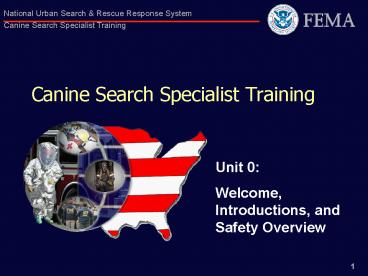Canine Search Specialist Training - PowerPoint PPT Presentation
1 / 34
Title:
Canine Search Specialist Training
Description:
Fitness for duty. Extended operations will reduce an individual's effectiveness over time ... connective boxes in base camp. Overloaded power circuits tapped ... – PowerPoint PPT presentation
Number of Views:173
Avg rating:3.0/5.0
Title: Canine Search Specialist Training
1
Canine Search Specialist Training
- Unit 0
- Welcome, Introductions, and Safety Overview
2
Welcome to the FEMA USR Canine
Search Specialist Training
3
Introductions
- Instructor cadre
- Hosting TF participants/Program Office
Staff/Eagle - Visitors
- Students
- Name
- Task Force
- CSS or STM
- K-9s name/age/breed/level
4
Ground Rules
- Classes will begin on time
- Attendance is mandatory
- Evening sessions
- Breaks last 15 minutes
- No smoking during class or exercises
5
Ground Rules (continued)
- Presentations will be interactive
- Questions and dialogue are encouraged
- Questions on non-unit material will be addressed
at the appropriate time - Notes should be taken
- Dress will be TF uniform (appropriate PPE when
required)
6
Administrative Details
- Class roster
- Student Manual (SM)
- Student CD-ROM
7
Course Objectives
- Function effectively as a search specialist and
canine team in the disaster environment - Perform the tasks according to procedures and
guidelines that are required of the Canine Search
Specialist position
8
Course Overview
- Consists of
- 15 instructional units
- Field exercises
- Final Operational Exercise
- Program Update/Certification Process
- Roundtable
9
Evaluation of Instruction
- Unit evaluations
- End-of-course evaluations
- Please complete
10
Safety Overview
11
Safety
- SAFETY IS A TEAM EFFORT
- All personnel must understand and do their part
to insure the health and safety of search and
rescue resources, and victims
12
Response Operations
- Risks/hazards are a part of what we do
- We need to focus on common hazards found at all
emergency scenes
13
Fitness for duty
- Extended operations will reduce an individuals
effectiveness over time - Being fit will alleviate many issues
14
Fitness for duty (continued)
- Disaster environmental issues
- Weather extremes
- Long hours
- Poor work conditions
- Poor sanitation conditions
- High levels of stress
15
Safety equipment
- PPE
- Safety boots
- Respirator
- Helmet/headlamp
- Protective clothing
- Radio
16
Security
- Civil disorder likely
- FEMA may be a target
- Curfews will affect USR operations
- BoO security
17
Secondary explosions
- Gases
- Fuels
- Dust
- Improvised Explosive Devices
18
Earthquake aftershocks
- Secondary collapses
- Confusion
- Loss of personnel accountability
19
Air transportation
- Proper loading
- Safety restraints
- Temperature
- Noise and vibration
- Rotors and props
20
Air operations in the vicinity
- Noise
- Rotor wash
- Dust and debris
- Blows unsecured items/personnel away
21
Ground transportation
- Movement of large trucks, forklifts, and gators
around BoO - Personnel transported in pickups and gators
22
Unfamiliar surroundings
- Roadways and bridges damaged or destroyed
- Access restricted
- Traffic signs and other landmarks may not survive
23
Injuries
- Injury to TF members is a serious concern
- Damaged medical infrastructure
- Everyone must take precautions to minimize
injuries
24
HazMat
- Be aware of potential exposure
- Direct exposure
- Indirect exposure
25
Decontamination
- Canine search teams must have ability to clean
and decon - Decon at appropriate time and place
26
Contaminated air and water
- Be aware of potential contaminants in
- Air
- Water
27
Food service
- Spoiled food
- Improperly prepared food
- Civilians with good intentions will donate food
to team members, but
28
Electrical hazards
- Re-energizing of power grids
- Jury-rigged connective boxes in base camp
- Overloaded power circuits tapped into by USR TFs
29
Adverse weather
- Have appropriate weather gear
- Be ready for varying conditions
NOAA
30
LCES
- L-Lookouts
- C-Communications
- E-Escape Routes
- S-Safe Zones
31
Safety during this course
- Safety principles will be adhered to at all times
- Report
- Unsafe conditions
- Injuries
32
Unit Summary and Evaluation
33
Unit Summary
- Introductions
- Ground rules and administrative details
- Course objectives
- Student evaluation
- Course evaluation
- Safety overview
34
Unit Evaluation
- Please fill out the evaluation form for this unit































